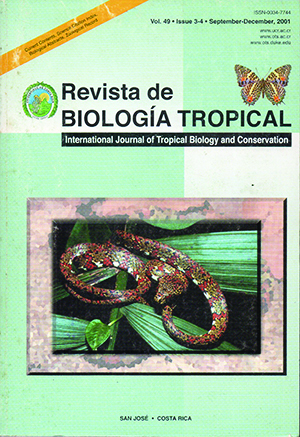Abstract
Jaú National Park is a large rain forest reserve that contains small populations of four caiman species. We sampled crocodilian populations during 30 surveys over a period of four years in five study areas. We found the mean abundance of caiman species to be very low (1.0 ± 0.5 caiman/km of shoreline), independent of habitat type (river, stream or lake) and season. While abundance was almost equal, the species’ composition varied in different waterbody and study areas. We analysed the structure similarity of this assemblage. Lake and river habitats were the most similar habitats, and inhabited by at least two species, mainly Caiman crocodilus and Melanosuchus niger. However, those species can also inhabit streams. Streams were the most dissimilar habitats studied and also had two other species: Paleosuchus trigonatus and P. palpebrosus. The structure of these assemblage does not suggest a pattern of species associated and separated by habitat. Trends in species relationships had a negative correlation with species of similar size, C. crocodilus and P. trigonatus, and an apparent complete exclusion of M. niger and P. trigonatus. Microhabitat analysis suggests a slender habitat partitioning: P. trigonatus was absent from river and lake Igapó (flooded forest), but frequent in stream Igapó. This species was the most terrestrial and found in microhabitats similar to C. crocodilus (shallow waters, slow current). Melanosuchus niger inhabits deep, fast moving waters in different study areas. Despite inhabiting the same waterbodies in many surveys, M. niger and C. crocodilus did not share the same microhabitats. Paleosuchus palpebrosus was observed only in running waters and never in stagnant lake habitats. Cluster analysis revealed three survey groups: two constitute a mosaic in floodplains, (a) a cluster with both M. niger and C. crocodilus, and another (b) with only C. crocodilus. Athird cluster (c) included more species, and the presence of Paleosuchus species. There was no significant difference among wariness of caimans between disturbed and undisturbed localities. However, there was a clear trend to increase wariness during the course of consecutive surveys at four localities, suggesting that we, more than local inhabitants, had disturbed caimans. The factors that are limiting caiman populations can be independent of human exploitation. Currently in Amazonia, increased the pressure of hunting, habitat loss and habitat alteration, and there is no evidence of widespread recovery of caiman populations. In large reserves as Jaú without many disturbance, most caiman populations can be low density, suggesting that in blackwater environments their recovery from exploitation should be very slow.##plugins.facebook.comentarios##

This work is licensed under a Creative Commons Attribution 4.0 International License.
Copyright (c) 2001 Revista de Biología Tropical
Downloads
Download data is not yet available.


